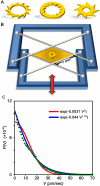Swimming bacteria power microscopic gears
- PMID: 20080560
- PMCID: PMC2824308
- DOI: 10.1073/pnas.0913015107
Swimming bacteria power microscopic gears
Abstract
Whereas the laws of thermodynamics prohibit extraction of useful work from the Brownian motion of particles in equilibrium, these motions can be "rectified" under nonequilibrium conditions, for example, in the presence of asymmetric geometrical obstacles. Here, we describe a class of systems in which aerobic bacteria Bacillus subtilis moving randomly in a fluid film power submillimeter gears and primitive systems of gears decorated with asymmetric teeth. The directional rotation is observed only in the regime of collective bacterial swimming and the gears' angular velocities depend on and can be controlled by the amount of oxygen available to the bacteria. The ability to harness and control the power of collective motions appears an important requirement for further development of mechanical systems driven by microorganisms.
Conflict of interest statement
The authors declare no conflict of interest.
Figures





References
-
- Feynman RP. The Feynman lectures on physics. Reading: Addison-Wesley; 1963.
-
- Van den Broeck C, Kawai R, Meurs P. Microscopic analysis of a thermal Brownian motor. Phys Rev Lett. 2004;93:090601. - PubMed
-
- Lee SH, Grier DG. One-dimensional optical thermal ratchets. J Phys-Condens Matter. 2005;17:S3685–S3695. - PubMed
-
- Lee CS, Janko B, Derenyi I, Barabasi AL. Reducing vortex density in superconductors using the ‘ratchet effect’. Nature. 1999;400:337–340.
-
- Rousselet J, Salome L, Ajdari A, Prost J. Directional motion of Brownian particles induced by a periodic asymmetric potential. Nature. 1994;370:446–448. - PubMed
Publication types
MeSH terms
Substances
LinkOut - more resources
Full Text Sources
Other Literature Sources

